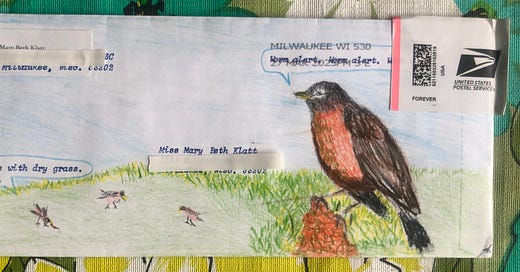A Book Review: From Ted to Tom: The Illustrated Envelopes of Edward Gorey
The Hottest Old Trend to Hit the U.S. Postal Service Plus Two of My Own
Life is too short not to travel first class.
—Wyndham Lewis
Life is also too short not to mail a first-class envelope adorned only with a postal stamp. Life is much too short not to write your recipient’s address up at the top of the envelope, centered on a yellow column, matching the yellow scrambled eggs inside a frying pan held by a midget in one hand, a fork in the other. Life is mighty short not to drape the recipient’s address (Tom Fitzharris, 39 Hickory Hill Road, Eastchester, New York 10709) along an envelope-long plume of smoke.
Illustrator Edward (Ted) Gorey wrote and illustrated more than 50 letters he sent to Fitzharris between 1974-1975, a correspondence remarkable for the illustrated envelopes, the notecards, letters written a typewriter and other ephemera.
It strikes me as timely that this correspondence has been published more than 50 years later (From Ted to Tom: The Illustrated Envelopes of Edward Corey) in the middle of a renaissance of illustrated envelopes, which began during the planned ‘demic five years ago.
What amazes me most about the illustrated envelopes featured in “From Ted to Tom” might be the lack of a return address Not one of the envelopes featured in the book has a return address on it. Not one. It’s almost as if Ed (Ted in the book) flung these envelopes in the mail box confident that they would make their way to Tom in Eastchester, New York 10709. (Wait! I see Gorey’s address embossed on the back of one envelope. Clearly the work of a letterpress printing press.)
But the book does reveal that at least one missive did get lost in the mail. Ed recreated it from practice drawings he made for that letter. I do this practice work with my own illustrated envelopes. More on those in a minute.
Ted’s envelopes are gems but the letters and notecards make you feel like you’ve stepped into his studio. (“The day is about to be filled with mysterious comings and goings, and I think I had better try and get some drawing done, even if my drawing paper resembles damp sponge to work on up here in the attic.”) The letters are written on a typewriter with a wonky typeface, filled with the latest news, opinions and the occasional surprise.
Ink splotches are here and there. It’s as if Ted spent the most time on the notecards, writing them out with a fine ink pen, evenly spacing out the letters and the words, centering it in the middle of the card. I imagine him writing out these notecards in batches, letting them dry, slipping them into envelopes along with an off-the-cuff, typed letter.
These notecards look they were printed on a letterpress printing press in in what could pass for a 18-point letterpress typeface. It’s hard to believe these are actually handwritten, but the writing’s perfect with uniform spacing, you’ll do a double take to check for imperfections. (They’re there).
Here are few of the quotes Ed wrote out with perhaps a fountain pen on his notecards. (He does mention using one in a letter.)
“Time is a horse that runs in the heart, a horse without a rider on a road at night. The mind sits listening and hears it pass.”
—The Pure Good of Theory, Wallace Stevens
or what about this:
‘Heigh ho!’ cried Fanny, ‘was ever such a tiresome carpet as this? It is quite impossible one should ever see anything that is dropt upon it.’
— A Visit to the Sea-Side
or even:
Nothing real is simple.
— AMIEL
I learned about this book in the Wall Street Journal (or maybe it was the New York Times). I immediately checked it out at Boswell Books, smitten with what was inside. I requested it at the local library, with the intention of using it to illustrate my own envelopes directed to a certain Typepal in California. (He sent me an illustrated envelope of his own).
Alas, that correspondence abruptly ended and I decided to send illustrated envelopes to myself. They travel all of about 300 feet to the post office across the street and return a day or two later in a mail truck. They’ve been coming back to my mail box faster and faster, perhaps because the postal clerks recognize my work and address.
I’m not the only one illustrating envelopes these days, ilustrated envelopes can be found all over Instagram. Writer Rachel Symes (Author of Syme’s Letter Writer) finds it gratifying that teenagers are illustrating and posting their work online, a group that wasn’t alive the last time illustrated envelopes were popular.
If these teenagers can find joy, the thrill of being alive in decorating an envelope, let them. If these teens can transmute that joy to a friend, let them. If these teenagers get one of the peers to create and send one illustrated envelope into the the world, let them.
If you’re so inclined and you like receiving letters in the mail, subscribe to my stamp fans.com monthly letter here.
(Let me know in the comments if you’ve illustrated and mailed an illustrated envelope.)






